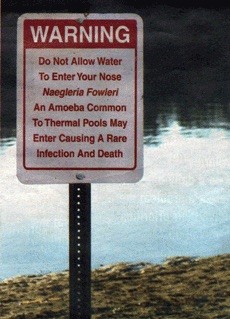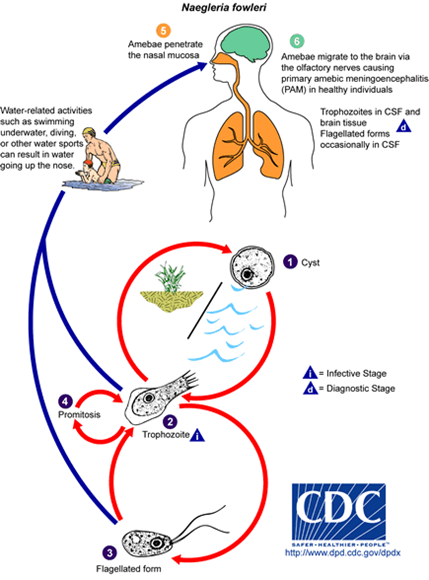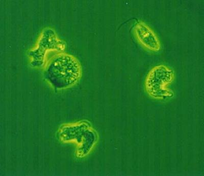Quick Facts
|
|
Primary amebic meningoencephalitis (PAM) is caused by the free-living ameba Naegleria fowleri and occurs most commonly in healthy children and young adults with recent recreational freshwater exposure. PAM due to N. fowleri has a worldwide distribution and occurs most frequently in tropical areas and during hot summer months. It is a rare disease in the United States and infection results from water containing N. fowleri entering the nasal cavity, followed by migration of the amebae to the brain via the olfactory nerve. Within the brain, N. fowleri causes extensive inflammation, hemorrhage, and necrosis, leading to death in 3 to 7 days. Initial symptoms include sudden onset of bifrontal or bitemporal headaches, high fever, nuchal rigidity, anorexia, vomiting, irritability and restlessness. Other symptoms such as photophobia, neurological abnormalities, including altered mental status, lethargy, dizziness, ataxia, cranial nerve palsy, hallucinations, delirium, coma may occur late in the clinical course.
 |
Naegleria fowleri warning sign |
Mortality among patients with PAM is over 95%. Optimum treatment for PAM has not been well defined. Amphotericin B remains a cornerstone of therapy for PAM, but this requires high dosage and its use is frequently associated with renal toxicity, manifested as azotemia and hypokalemia. Amphotericin B also may cause anemia, and many patients experience chills, fever, nausea, vomiting, and headache. Moreover, only ten persons with PAM have been treated successfully worldwide with amphotericin B alone or in combination with other drugs. Recently, an investigational breast cancer and anti-Leishmania drug, miltefosine, has shown some promise in combination with other drugs and a patient was successfully treated with miltefosine and hypothermia. But another patient, though treated with miltefosine, suffered permanent brain damage. Therefore, fast-acting and efficient drugs are urgently needed for the treatment of PAM.
What is it?
Naegleria fowleri is a free-living amoeboflagellate. There are three stages in its life cycle: trophozoite, flagellate, and cyst. The trophozoite is the only infective stage of the ameba. Trophozoites can turn into a temporary, non-feeding, flagellated stage when stimulated by adverse environmental changes such as a reduced food source. They revert back to the trophozoite stage when favorable conditions return. If the environment is not conducive to continued feeding and growth (like cold temperatures, food becomes scarce) the ameba or flagellate will form a cyst. Cysts are environmentally resistant in order to increase the chances of survival until better environmental conditions occur.

Where does it occur?
 Naegleria fowleri has been detected on all continents except Antarctica. It has been described as the cause of PAM in more than 16 countries. Until 2012, about 310 cases have been reported globally. N. fowleri infection is not a notifiable disease in the US. Based on the free-living ameba registry maintained by the CDC, 138 case reports of PAM have occurred in the US from 1962-2015. Out of 138 cases, 135 cases have been fatal and there are only three survivors, which means the infection has a fatality rate of nearly 98 percent. In the United States, PAM is a rare disease and occurs disproportionally among children of less than 13 years.
Naegleria fowleri has been detected on all continents except Antarctica. It has been described as the cause of PAM in more than 16 countries. Until 2012, about 310 cases have been reported globally. N. fowleri infection is not a notifiable disease in the US. Based on the free-living ameba registry maintained by the CDC, 138 case reports of PAM have occurred in the US from 1962-2015. Out of 138 cases, 135 cases have been fatal and there are only three survivors, which means the infection has a fatality rate of nearly 98 percent. In the United States, PAM is a rare disease and occurs disproportionally among children of less than 13 years.

